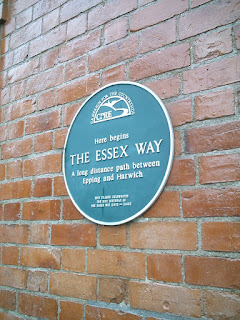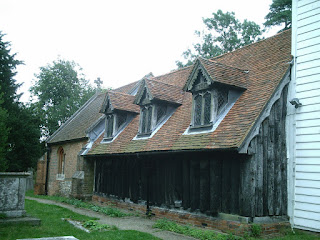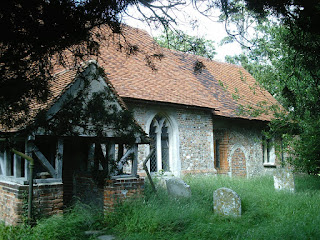
Setting out from Epping station to walk to Berners Hall farm seemed like a good idea at the time. I had plenty of time to do it and the weather was perfect for a fairly long distance walk. I would take in a couple of old (one extremely old) churches and be at the farm by the appointed time of 1500. However the walk was slightly longer than I had anticipated and I had to get a taxi for part of the way.
The Essex Way runs from Epping to Harwich and goes for 81 miles through some of the Essex countyrside. The first part crosses a railway bridge and soon enters open fields. The natives were friendly with several calling cheery hellos. Coopersale Street had some attractive houses and I later found out it is a conservation area. Essex fields are very enclosed, where there is livestock with electric fences creating hazards. The worst of this was in Toot Hill Village where an electric fence had been placed across the path, so that travellers had to duck it. I had a shandygaff in the Green man at Toot Hill (more a restaurant than a pub though) before walking quickly on. The countryside was quite ordinary, but on the route was Greensted Church,
 a saxon church built of wood, that had survived from those days, although much altered. It must be marvellous for the congregation at their Sunday worship to know they are sitting in a building used by saxons. The wooden walls were preserved from decay in Victorian times by having a brick wall placed underneath them - similar to a footing. They also added three dormer windows. The nave roof was tiled in Tudor times which was when the chancel was built in brick. The Tudors also installed three dormer windows. The church is a remarkable survival, and to touch the timber is to touch history.
a saxon church built of wood, that had survived from those days, although much altered. It must be marvellous for the congregation at their Sunday worship to know they are sitting in a building used by saxons. The wooden walls were preserved from decay in Victorian times by having a brick wall placed underneath them - similar to a footing. They also added three dormer windows. The nave roof was tiled in Tudor times which was when the chancel was built in brick. The Tudors also installed three dormer windows. The church is a remarkable survival, and to touch the timber is to touch history.Eventually it was time to move on past the invisible Greensted Hall (I could only see its garden complete with lake) and walk across the fields to Chipping Ongar, which was known to passengers on the Central Line of the London Underground as Ongar. London Underground seem to have an aversion to the word 'chipping' as the station at High Barnet really serves Chipping Barnet.

Chipping Ongar was where David Livingstone lived for a while, but I missed the United Reformed Church where he preached. I did see the old church of St Martin of Tours. This church had an anchorite's cell next to the altar and remains of ancient work including roman bricks. The 15th century font was dug up in a garden in the town, and restored to the church in 1963.
By the time I had finished in the church it was time to go to Berners Roding, a tiny hamlet and location of the Coöperative Farm.
The Farm Manager spoke about the history and current production of the farm and showed fields of wheat and peas as well as a shiny, new combine harvester. People of my generation and older will now be thinking of The Wurzels!
We were also shown the former church of Berners Roding, completely empty except for two memorials, a prayer desk, stool and pulpit. The church was clearly old (although hard to date) and clearly in a state of decay with the floorboards lifting and cracks in the walls.



No comments:
Post a Comment